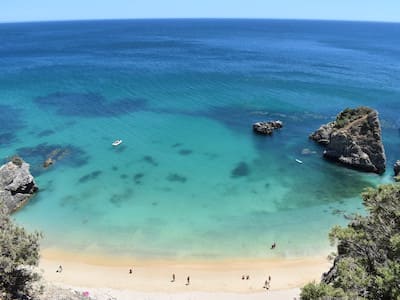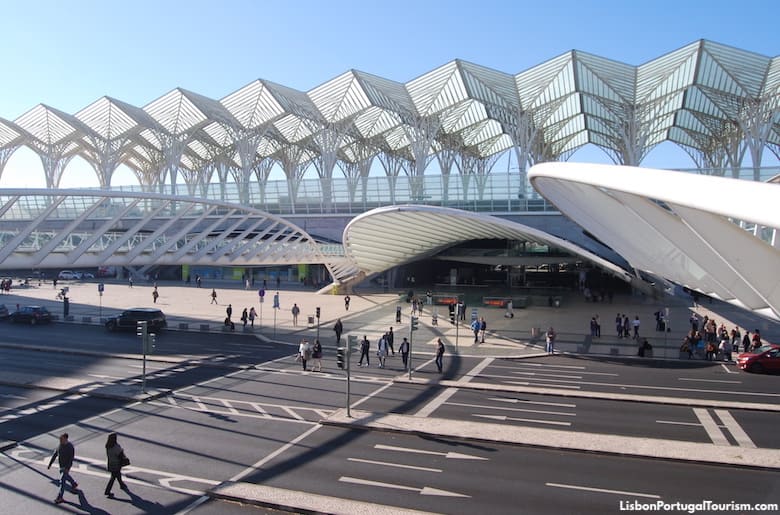
Oriente Station, a major transportation hub, connecting trains, metro, and buses
Lisbon's historic and tourist center is compact enough to explore on foot, and walking around is the best way to see the city. However, you'll need to take public transportation to reach the main landmarks in the Belém district, the museums of Avenidas Novas, the magnificent Tile Museum, and Parque das Nações.

Interior of a classic Lisbon tram
Lisbon's transportation is actually one of its main attractions, with no tourist ever leaving the city without riding one of the vintage trams and funiculars. Those wishing to go on a day trip to Cascais or Sintra, will need to take the train. There is also the possibility of seeing the city from the river, by taking a commuter ferry to Cacilhas.

The Bica Funicular
Most forms of public transportation operate from around 6am to midnight (the metro until 1am), so outside these hours you'll need to take a taxi (which are quite inexpensive).
Bus and tram tickets are bought from the driver, except on tram 15 which has ticket machines inside (coins only). However, a transportation card is a major time and money saver (more details below).
Many (but not all) bus and tram stops have displays with the time remaining until the next vehicle, but they're not always accurate, as double-parked cars and other obstacles often get in the way.
Also note that trams are indicated by an "E" after their number ("28E" is tram 28).
Always hold on to your ticket until the end of the trip in case of inspection.
Also important is remembering to respect the queues and entering the trams and buses in order.
Lisbon Travel Cards
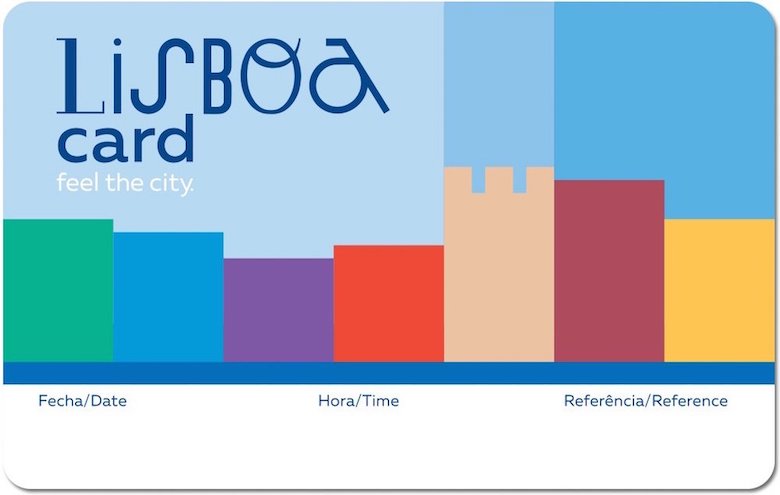
The Lisboa Card is the best option for tourists
Lisboa Card
The Lisboa Card is the best option for tourists, as it not only offers free admission to most monuments and museums, it includes unlimited rides on the buses, trams, funiculars, trains, and metro. You can buy it for periods of 24, 48, or 72 hours. It covers all transportation within Lisbon (except for the special AeroBus from/to the airport), as well as trains to Cascais and Sintra.
Order it here: Lisboa Card
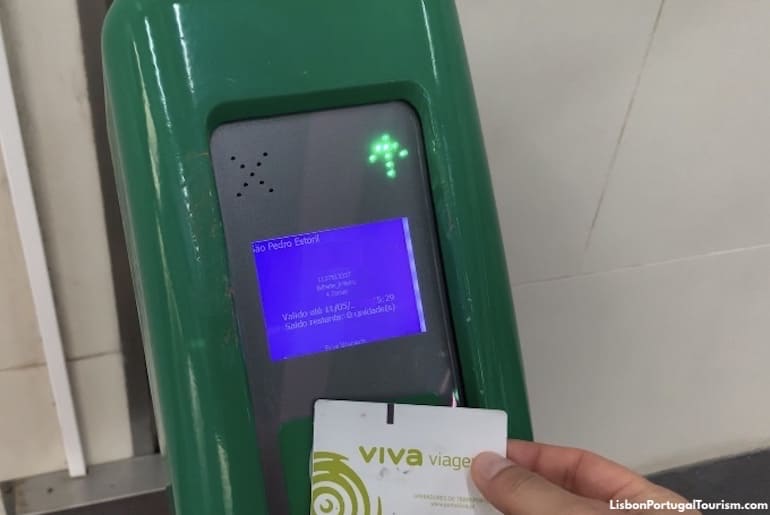
The Viva Viagem card being validated at a train station
“Viva Viagem” Card
Those who choose not to acquire the Lisboa Card, will need the Viva Viagem. It’s a magnetic card that can be purchased from the machines at any metro station. It costs €0.50 and is valid for 12 months. It can be used to charge metro or bus fare, or a 24-hour ticket for €6.60, which allows unlimited rides on all public transportation within Lisbon. To include the trains to Cascais and Sintra, there's a 24-hour ticket for €10.70.
A Viva Viagem can only be used by one person, so if you’re traveling as a family, every member should get their own.
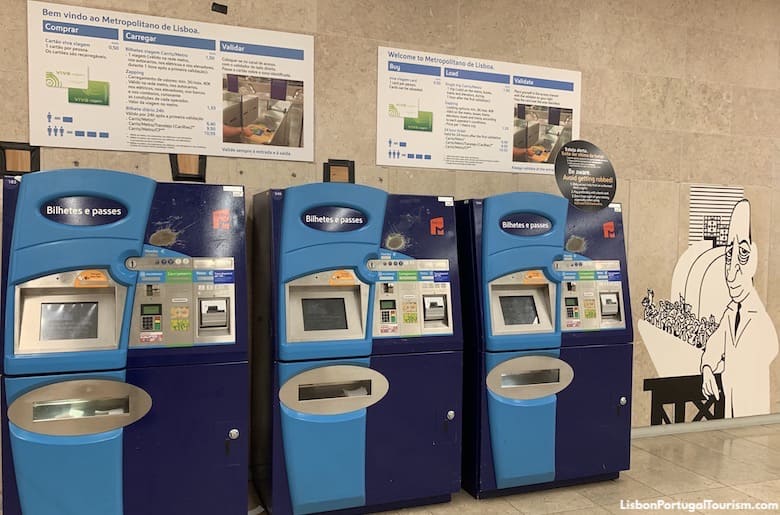
Lisbon Metro ticket machines where you can buy the Viva Viagem card and charge it with the different tickets
“Zapping” Ticket
Inconveniently, the Viva Viagem card only accepts one type of fare at a time, so if you charge metro tickets, you can’t then add train tickets (except for the 24-hour ticket mentioned above, which covers all forms of transportation). However, you may choose to charge it with a ticket called “Zapping,” which is a credit of amounts ranging from €3 to €40 (it can be charged at any machine on the metro). It can then be used to pay all public transportation. It deducts €1.47 every time you ride the metro, buses or trams, and €1.90 for the train.

Inside a Lisbon metro train
Lisbon Metro
Lisbon's metro has four lines and is the fastest way to get to locations in the central and northern parts of the city. Unfortunately, it doesn’t reach the districts to the west (Alcântara and Belém), or the hilly neighborhood of Graça and the highest part of Alfama. Its red line connects the airport to the city center.
See the Lisbon Metro guide
Lisbon Buses
Because the metro does not cover the entire city, the bus is the only way to reach a few tourist attractions, like the Tile Museum and Fronteira Palace. It can also be an alternative to the crowded trams.
See the Lisbon buses guide
Lisbon Trams
The iconic trams go through the narrow and picturesque streets of the oldest parts of Lisbon, and also to Belém's monuments to the west. However, they’re usually too crowded and much slower than the buses or trains.
See the Lisbon trams guide
Lisbon Funiculars
The landmark funiculars or elevators transport locals and tourists to the top of the city's steepest hills. Powered by electricity, they’re an environmentally-friendly way to reach the highest neighborhoods, like Bairro Alto.
See the Lisbon funiculars guide
Lisbon Trains
Trains take commuters and tourists to Sintra and Cascais, but are also the best way to reach the western districts in the city (Alcântara and Belém).
There are four major train stations in Lisbon -- Santa Apolónia for long-distance destinations, Cais do Sodré for the resorts of Cascais and Estoril, Rossio for Sintra, and Oriente for the northern and western suburbs and for most destinations within Portugal. Trains to Cascais (stopping in Estoril and other beach towns) depart about every 20 minutes, reaching the final destination in 40 minutes.
Sintra can also be reached in less than 40 minutes by trains departing every 20 minutes throughout the day (all rides to Sintra, Cascais or Estoril are free with the Lisboa Card).
The national rail company is CP ("Comboios de Portugal"), which connects the capital to the major cities of the country. The Intercidades is a comfortable service, but the fastest (with fewer stops) is the Alfa Pendular.
Always validate your ticket before boarding the trains.
Lisbon Taxis and Ridesharing
Lisbon's taxis are mostly beige Mercedes, although there are also a few older black and green ones. They're much cheaper than in most other European cities -- usually between 5 and 10 euros for any ride within the city (a little more expensive after 10pm, on weekends and public holidays). All have meters (make sure they're switched on), and tips are not expected. They line up in many central areas, including train stations, Rossio Square and Praça Luís de Camões. If you need to call for one, try Rádio Taxis (218 119 000) or Autocoope (217 932 756).
Taxis transport up to four people, so when the cost is split among the group, they may actually come out cheaper than buses or trams (unless, of course, you have the Lisboa Card).
See the Lisbon taxis guide
Lisbon Ferries
Ferries departing from Terreiro do Paço (by Praça do Comércio) and Cais do Sodré connect Lisbon to the suburbs across the river. The only service used by tourists is the one that goes between Cais do Sodré and Cacilhas, from where they can reach the Cristo Rei monument and the beaches of Costa da Caparica by bus.
See the Lisbon ferries guide
Lisbon Tuk Tuks
Tuk tuks are rather recent in Lisbon. Imported from Asia, they’ve become a favorite way for tourists to go around the narrow and hilly streets. They’re not public transportation -- they essentially provide tourist services and have a minimum charge.
See the Lisbon tuk tuks guide


